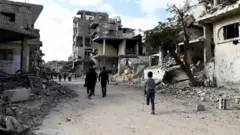Following months of intense conflict, a fragile ceasefire has settled over Gaza, but beneath the silence of bombs, the streets of Gaza reveal a landscape of profound devastation. Rescue workers and civilians are beginning the arduous task of assessing the sheer scale of destruction that has been wrought upon the Strip.
Gaza’s Civil Defence agency, the primary emergency response service, has voiced fears that over 10,000 bodies remain buried beneath the vast expanse of rubble that now defines many Gaza Streets. Spokesman Mahmoud Basal, in a statement to the BBC, indicated the grim reality that recovering the deceased could take up to 100 days, a timeline potentially extended by a critical shortage of bulldozers and essential equipment. New imagery emerging from Gaza after the ceasefire vividly illustrates the extent of the destruction inflicted during the prolonged offensive, particularly impacting the northern regions of the enclave. The scars of conflict are etched deep into Gaza streets.
 Reuters People, including a child on a crutch, missing the lower half of his left leg, walk past the grey, dusty rubble of houses and buildings destroyed during the war in Al-Bureij in central Gaza
Reuters People, including a child on a crutch, missing the lower half of his left leg, walk past the grey, dusty rubble of houses and buildings destroyed during the war in Al-Bureij in central Gaza
Palestinians navigate the rubble-strewn streets of Gaza, a stark reminder of the conflict’s impact on civilian life and urban infrastructure.
The Humanitarian Crisis Unfolding on Gaza Streets
The United Nations had previously estimated that a staggering 60% of structures across Gaza have suffered damage or complete destruction. While the celebratory sounds of the ceasefire replaced the terrifying echoes of bombing, the daily reality for people across Gaza streets remains overwhelmingly desperate.
According to the UN World Food Programme (WFP), the prolonged conflict has rendered over two million Gazans homeless, stripping them of their livelihoods and making them entirely reliant on food aid for survival. Immediately following the ceasefire, aid began flowing into Gaza, with the UN reporting that at least 630 lorries entered the Strip on Sunday alone. Monday saw a further influx of 915 lorries, marking the highest single-day aid delivery since the war commenced 15 months prior. However, the scale of need on Gaza streets far surpasses the initial aid efforts.
 EPA Destuction in Khan Younis in the Gaza Strip following the Israeli army withdrawal from the region
EPA Destuction in Khan Younis in the Gaza Strip following the Israeli army withdrawal from the region
Khan Younis streets bear witness to the extensive destruction after the Israeli army’s withdrawal, highlighting the urgent need for reconstruction.
Sam Rose, acting director of Unrwa, the UN’s Palestinian refugee agency in Gaza, emphasized that the incoming aid supplies are merely the first step in a monumental undertaking to revitalize the devastated strip. “We’re not just talking about food, healthcare, buildings, roads, infrastructure, we’ve got individuals, families, communities that need to be rebuilt,” Rose stated. He further highlighted the profound and lasting trauma endured by the population: “The trauma that they’ve gone through, the suffering, the loss, the grief, the humiliation, and the cruelty that they’ve endured over the past 16 months – this is going to be a very, very long road.” The psychological scars on Gaza streets are as deep as the physical ones.
Glimmers of Hope and Personal Tragedies Amidst Gaza Streets
In Israel, amidst the backdrop of Gaza’s devastation, families of the three hostages freed in the initial exchange shared their experiences at a Tel Aviv news conference. Mandy Damari, mother of Emily Damari, described her daughter’s “high spirits” and journey “on the road to recovery,” despite the horrific ordeal and loss of two fingers during the Hamas attack on 7 October 2023.
Meirav Leshem Gonen, Romi Gonen’s mother, expressed relief and empathy: “We got our Romi back, but all families deserve the same outcome, both the living and the dead. Our hearts go out to the other families.” Prior to the news conference, Israeli authorities released poignant footage capturing the emotional reunions of Damari, Gonen, and Doron Steinbrecher with their mothers moments after their release from Gaza. The ceasefire agreement, if sustained, promises the release of 30 additional hostages from Gaza over the subsequent 40 days, in exchange for approximately 1,800 Palestinians held in Israeli jails, offering a fragile hope amidst the despair witnessed on Gaza streets.
The Grim Reality of Loss on Gaza Streets
Palestinian health authorities estimate a staggering loss of life in Gaza: over 46,900 people killed and more than 110,700 wounded during the 15 months of conflict. While the ministry does not differentiate between civilian and combatant casualties, they assert that the majority of the deceased are women and children – a claim corroborated by UN findings. A UK-led study published in The Lancet suggests that the official figures might significantly underestimate the actual death toll by over 40%.
The Gaza Civil Defence agency itself has suffered immense losses, reporting that 48% of their personnel have been killed, injured, or detained, and 85% of their vehicles and 17 out of 21 facilities have been damaged or destroyed. Despite the cessation of airstrikes, the perilous work continues for the remaining Civil Defence workers. Harrowing images shared by agency members in northern Gaza depict the grim task of recovering deceased infants and badly decomposed human remains.
“In every street there are dead. In every neighbourhood there are people under the buildings,” recounted Abdullah Al-Majdalawi, a 24-year-old Civil Defence worker in Gaza City. “Even after the ceasefire we received many calls from people saying please come, my family is buried under the rubble.” The phrase “in every street there are dead” encapsulates the tragic reality of Gaza streets.
 EPA An aerial view taken with a drone shows internally displaced Palestinians walking along a street among the grey, dusty rubble of destroyed buildings in Rafah
EPA An aerial view taken with a drone shows internally displaced Palestinians walking along a street among the grey, dusty rubble of destroyed buildings in Rafah
An aerial perspective of Rafah streets, showing displaced Palestinians walking amidst the overwhelming rubble, illustrating the scale of urban destruction.
Malaak Kasab, a 23-year-old graduate displaced from Gaza City, shared her personal tragedy: “We have lost a lot of members of our family and some are still under the destroyed buildings,” she said. “There are a lot of people under the rubble – everybody knows about this.” Kasab’s family home, though not completely destroyed, is severely damaged and uninhabitable, lacking basic necessities. Movement across Gaza streets remains fraught with danger as the Israeli military initiates its withdrawal from populated areas. The Israel Defence Forces (IDF) has issued warnings against approaching personnel or installations and entering buffer zones, further restricting movement for Gazan civilians attempting to navigate their devastated streets.
Rebuilding Lives and an Uncertain Future for Gaza Streets
Despite the immense challenges and dangers, Gazan residents are beginning to contemplate the daunting task of rebuilding their lives amidst the ruins of Gaza streets. Hatem Eliwah, a 42-year-old factory supervisor from Gaza City, sheltering in Khan Younis, expressed a desperate yearning to return home: “We have been waiting for this ceasefire like people waiting to enter heaven,” Eliwah said. “I lost two of my brothers and their families. I lost cousins, uncles. The only thing I still hope for is to go home.”
However, deep-seated concerns persist on both sides regarding the ceasefire’s fragility. Israel has explicitly reserved the right to resume military action at any moment, casting a shadow of uncertainty over the future of Gaza streets. Addressing the UN Security Council, Secretary-General Antonio Guterres acknowledged the ceasefire as a “ray of hope” but cautioned about the escalating situation in the West Bank, marked by increased Israeli settler attacks on Palestinian villages. Guterres also highlighted alarming statements from senior Israeli officials regarding potential annexation of West Bank territories, emphasizing that “Any such annexation would constitute a most serious violation of international law.” The path to recovery for Gaza streets is long and uncertain, dependent on sustained peace and international commitment to rebuilding not just infrastructure, but lives and communities.

